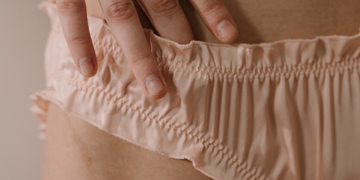Can I get a yeast infection after taking antibiotics?

The human microbiome is made up of many microorganisms working together to run different systems in the body. When any part of the microbiome changes in your body, it can cause an imbalance or type of dysfunction. When yeast thrives and becomes overgrown, you get a yeast infection. The use of antibiotics is one of a few causes that can lead to a yeast infection developing.
We’ll discuss why yeast infections can occur after taking antibiotics, some of the antibiotics which increase the risk of developing a yeast infection, how to recognize a yeast infection, and what kinds of treatment exist.
Can antibiotics cause yeast infections?
There’s a link between the use of antibiotics and the potential risk of developing a yeast infection. There are some antibiotics that kill a broad range of bacteria, rather than targeting specific bacteria. Broad-spectrum antibiotics (those that kill a range of bacteria) won’t discern between harmful bacteria and bacteria that should be present (a term referred to as “normal flora” found in different areas in your body). These broad-spectrum antibiotics often list yeast infection as a possible side effect. yeast-infection-complete-combo
Yeast infections after antibiotics
The likelihood of getting a yeast infection after taking antibiotics changes with the duration and dose of treatment, and specific medication. Your chances of developing a yeast infection increase when you take a stronger medication or have a long treatment cycle. We suggest chatting with your primary care provider about any concerns you have about starting antibiotics and developing a yeast infection as a side effect.
Why do antibiotics cause yeast infections?
When there is an increase in yeast, the balance of microorganisms in your vaginal microbiome changes and can lead to yeast infection. Some of the bacteria (a natural part of your vaginal microbiome) are meant to keep the amount of yeast balanced with the rest of the microorganisms present.
“Good bacteria”, or bacteria serving a purpose, might be killed when you take a broad-spectrum antibiotic. When this happens, due to the imbalance of good bacteria present to fend off excess yeast, this will all the yeast to grow in an uncontrolled way, leading to a yeast infection.
List of antibiotics that cause yeast infections
Broad-spectrum antibiotics, rather than antibiotics with a narrow target, are more likely to lead to yeast infections because the antibiotic will likely kill many types of bacteria. These antibiotics don’t distinguish between “bad bacteria” and “good bacteria.” Medications that increase your chances of getting a yeast infection include:
- Certain types of penicillin including amoxicillin and augmentin
- Steroids such as prednisone
- Tetracyclines like doxycycline
Other risk factors that increase the chance of getting a yeast infection
Understanding what can lead to a yeast infection can help you identify when you may need to be seen to have a diagnosis and discussion about treatments to resolve it. So what increases your risks of getting a yeast infection? Attributes that can impact the likelihood of getting a yeast infection include:
- Uncontrolled diabetes
- Hormonal changes due to pregnancy, birth control, and hormone therapy (among other shifts)
- A weakened immune system (due to HIV, for example)
- Scratches or other injuries to the vagina
- Sexual activity
Signs that you might have a yeast infection
It is important to get a diagnosis from your primary care provider to ensure you will be treated for the correct infection with the right types of medications. STIs and UTIs both have overlapping symptoms and can be mistaken for a yeast infection. Pay attention to the appearance of your vagina (redness, rash, etc.), whether you’re sore or in pain, and the type of discharge you’re experiencing. What you’re experiencing is possibly a yeast infection if:vaginal-ph-test-for-yeast-infections
- Discharge is watery
- Discharge has a cottage cheese-like consistency (thick and white)
- Your vagina is sore or has a rash
- Your vagina and vulva are itchy and irritated
- There’s a burning sensation during sex or when you pee
Can you prevent yeast infections?
Some claims of preventative practices or at-home treatments have weak evidence showing that they are effective. According to one study, dietary changes do not have an impact on your chances of getting a yeast infection.
Wearing breathable clothing, making sure to promptly change out of wet clothing, and paying attention to hygiene practices are all still recommended. Vaginal douching and using scented soaps can increase the risk of infection. Extremely hot water (like hot tubs or in the bath) can also increase the risk of developing a yeast infection. It might be helpful to see what your primary care provider suggests if you experience yeast infections frequently.
Yeast infection treatments
yeast-3-day-infection-treatmentThe majority of yeast infections are minor-moderate cases and can be treated in one to seven days. You may be advised to use an antifungal ointment (often found over-the-counter) or a single-dose pill. For a severe case, treatment can last six months. Your primary care provider may recommend long-course vaginal therapy in which you use antifungal medication daily for two weeks before switching to weekly use for another six months. There are also multi-dose oral medications.
Be sure to complete the medication cycle for whichever treatment method is recommended or the yeast infection may come back, and potentially increase your chances of getting more infections in the future.
We suggest speaking with your primary care provider if you’re concerned a medication you’re taking will lead to a yeast infection.
Keep Reading

Why do I get yeast infections around my period?
November 18, 2022

How to use a vaginal pH test for vaginal infections
Dec 1

How do yeast infections affect sex?
Sep 19







